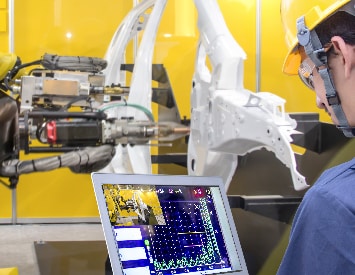The concept of the metaverse has gained increasing attention in recent years. We explore how the industrial metaverse revolutionizes the engineering industry and the learning experience.
What is the industrial metaverse?
The metaverse concept – a virtual world that spans multiple platforms and devices – has gained traction recently. A subset of the metaverse, the industrial metaverse focuses on using virtual and augmented reality technologies in the industrial sector. This technology has enormous potential for engineers, allowing them to design, test, and troubleshoot industrial systems in a virtual environment, improving efficiency and safety.
The industrial metaverse comprises a digital twin, a virtual replica of a physical system, such as a factory or a power plant. The digital twin is connected to the physical system, allowing real-time monitoring and control. Engineers are using the digital twin to simulate the behavior of the physical system under various conditions, making it possible to test different scenarios without making any material or physical changes.
One of the significant benefits of the industrial metaverse is that it enables engineers to identify and solve problems before they occur in the physical system. For example, if a component of a machine is failing in the digital twin, engineers can troubleshoot the problem and come up with a solution before the actual machine fails. This saves time and money and reduces the risk of accidents and injuries.
Another benefit of the industrial metaverse is that it allows engineers to design and optimize systems more efficiently. They can test various designs and configurations in the virtual environment, reducing the need for physical prototypes. This speeds up the design process and reduces costs and waste.

Digital Twins And The Industrial Metaverse
One of the more prominent use cases for the industrial metaverse is “digital twins,” or accurate simulations of real-world objects such as walkways, buildings, factory floors, conveyor belts, and robots.
Rev Lebaredian, vice president of Omniverse and simulation technology at Nvidia Corp., said digital twins create several “superpowers” for manufacturing that didn’t exist before because suddenly enterprise customers have access to fully realized simulated virtual versions of their factories they can work with.
These superpowers include teleportation, such as workers being able to jump to any point on a factory floor no matter where they are in the world and see what’s going on in a digital twin, as long as it’s simulating what’s happening right now in the real one. Or they can time travel into the past, where the factory’s activity could be recorded and played back so that anomalies could be viewed to see how they happened – or even better, time travel into the future by speeding up the simulation and watching what will happen.
Digital twins also allow designers to build entire apparatus or factory floors in virtual prototypes and simulate them before they put them into actual production. The aim is to see how they will operate and if there will be any potential problems. It permits them to experiment, optimize and streamline them before potential anomalies happen in the real world, thus reducing the risk of failures or safety issues for human workers.
Tony Hemmelgarn, president, and chief executive of Siemens Digital Industries Software, told SiliconANGLE that Siemens has been using digital twins in its own manufacturing processes and with customers for many years. What the industrial metaverse brought to digital twins is comprehensive simulation.
“I remember the first time I did a 3D model, a 3D wireframe – before you had solid modeling,” Hemmelgarn said. “You went from 2D drawings, where the business started, to a 3D wireframe. And I remember the first time I rotated one around on a screen, and someone behind me said, ‘Wow, why would you ever need more than that?’”
With the advances in industrial metaverse technologies, engineers can see entire factory floors with fully comprehensive, immersive views and simulate confidently. Now, Hemmelgarn said, “teams can come together and see it. I think that’s the real promise of the industrial metaverse.
The Industrial Metaverse Is Changing How Engineering Firms Train Staff
So much more than just speeding up the design process and reducing costs and waste, the industrial metaverse also has applications in training and education. Engineering firms are also using the virtual environment to train new employees and simulate hazardous scenarios, putting no one in danger. This can improve safety and reduce the risk of accidents and injuries.
Besides engineering, the industrial metaverse has potential applications in other areas, such as maintenance, logistics, and supply chain management. For example, logistics companies could use the technology to simulate different routes and optimize delivery schedules, while manufacturers could monitor inventory levels and optimize production schedules.
As metaverse technology continues to grow, more industries are expected to adopt the industrial metaverse to improve efficiency, safety, and sustainability.
Although it is apparent that industrial metaverse technology is becoming increasingly popular in the engineering industry, its use is not limited to just the professional field. The application of industrial metaverse technology in engineering education is also gaining popularity because it provides hands-on training in a virtual environment, prepares students for real-world scenarios, and improves their critical thinking and problem-solving skills.
The Industrial Metaverse Is Revolutionizing Engineering Education
Using industrial metaverse technology in engineering education has several advantages. One of the significant benefits is that it provides students with a safe and cost-effective environment to practice and test their engineering skills. This technology allows students to simulate real-world situations without the risk of harm or damage to physical equipment, reducing the need for expensive equipment and the cost of maintenance and repairs.
Furthermore, industrial metaverse technology enables students to collaborate with their peers and instructors to work on complex engineering projects. This virtual environment allows students to interact with experts from different locations, share knowledge and ideas, and work together on a project. This collaboration can help them develop a broader perspective on engineering issues and learn from different viewpoints.
Another advantage of industrial metaverse technology is that it enhances the learning outcomes of engineering students. The technology enables students to visualize engineering problems and design solutions in a realistic environment, improving their critical thinking and problem-solving skills. This approach also provides students with a deeper understanding of the principles of engineering and its applications in real-world scenarios.
Industrial metaverse technology also allows engineering educators to customize the learning experience according to individual student needs. The virtual environment can provide feedback, guidance, and support, enabling students to improve their understanding of the subject and master complex engineering concepts.
Using industrial metaverse technology in engineering education can help bridge the gap between theoretical knowledge and practical applications. By simulating real-world scenarios, students can apply their theoretical knowledge and see how it works in a practical setting, giving them a better understanding of the subject.

Boundless Benefits for Engineering Students
Industrial metaverse technology has many benefits for engineering students, including:
Real-world experience: Industrial metaverse provides engineering students with a virtual environment to practice real-world scenarios without risking damage to physical equipment or harm to themselves.
Collaboration: Students can collaborate with each other and with industry experts from different locations, allowing them to share knowledge and ideas and work together on complex projects.
Improved learning outcomes: Using industrial metaverse technology can help engineering students understand complex systems better and enhance their critical thinking and problem-solving skills.
Enhanced safety: Industrial metaverse allows students to practice and develop safety procedures for potentially hazardous scenarios with no risks of accidents or injuries.
Accessibility: Industrial metaverse technology is accessible to engineering students and from any location with an internet connection.
Overall, industrial metaverse technology in engineering education can provide students with an enhanced learning experience, better prepare them for real-world engineering scenarios, and potentially even create opportunities for new technological advancements.

Future Paths of The Industrial Metaverse
During the recently-held World Economic Forum in Davos, Switzerland thought leaders discussed the industrial metaverse and its future paths. While the exact vision and its implementation remain uncertain, it is clear that the technologies underpinning different visions of an industrial metaverse mainly exist already.
For example, key technologies include digital twins, the internet of things (IoT), artificial intelligence, cloud and edge computing, blockchain, and extended reality. Supportive technology infrastructures are also active, such as 5G networks for low-latency data communication and robotic systems.
What needed to be clarified from the Davos discussions was how decision-makers should react to the emergence of an industrial metaverse. However, every company will have to make decisions about the industrial metaverse.
To help make these decisions and start a global conversation of decision-makers, we describe a future that may await companies in an industrial metaverse and highlight some of the pitfalls that must be circumnavigated. These include but are not limited to the following:
Technology and operations: A high degree of digitalization will allow for a more straightforward implementation of solutions, accelerating the adoption of full-scale digital twin factories, supply chains, and related infrastructure operations and management such as transportation, city planning, and energy management.
Data and security: Data can be seamlessly shared within organizations and selectively shared with suppliers and customers. Security, privacy, data biases, and data-based discrimination may be solved. This allows meta-analyses of data, extensive know-how aggregation, and automated AI solutions.
Work: In the industrial metaverse, digital work opportunities abound. Because physical and digital worlds are tightly interwoven, this allows new opportunities for distributed work and makes workers more geographically independent from locations. New human-machine interactions proliferate.
Competition: The industrial metaverse enables a wide range of complementary services. This enables a rich ecosystem of specialized providers and many new innovative services to be connected to – and used in – the industrial metaverse.
REFERENCES:
The Industrial Metaverse: A Game-Changer For Operational


